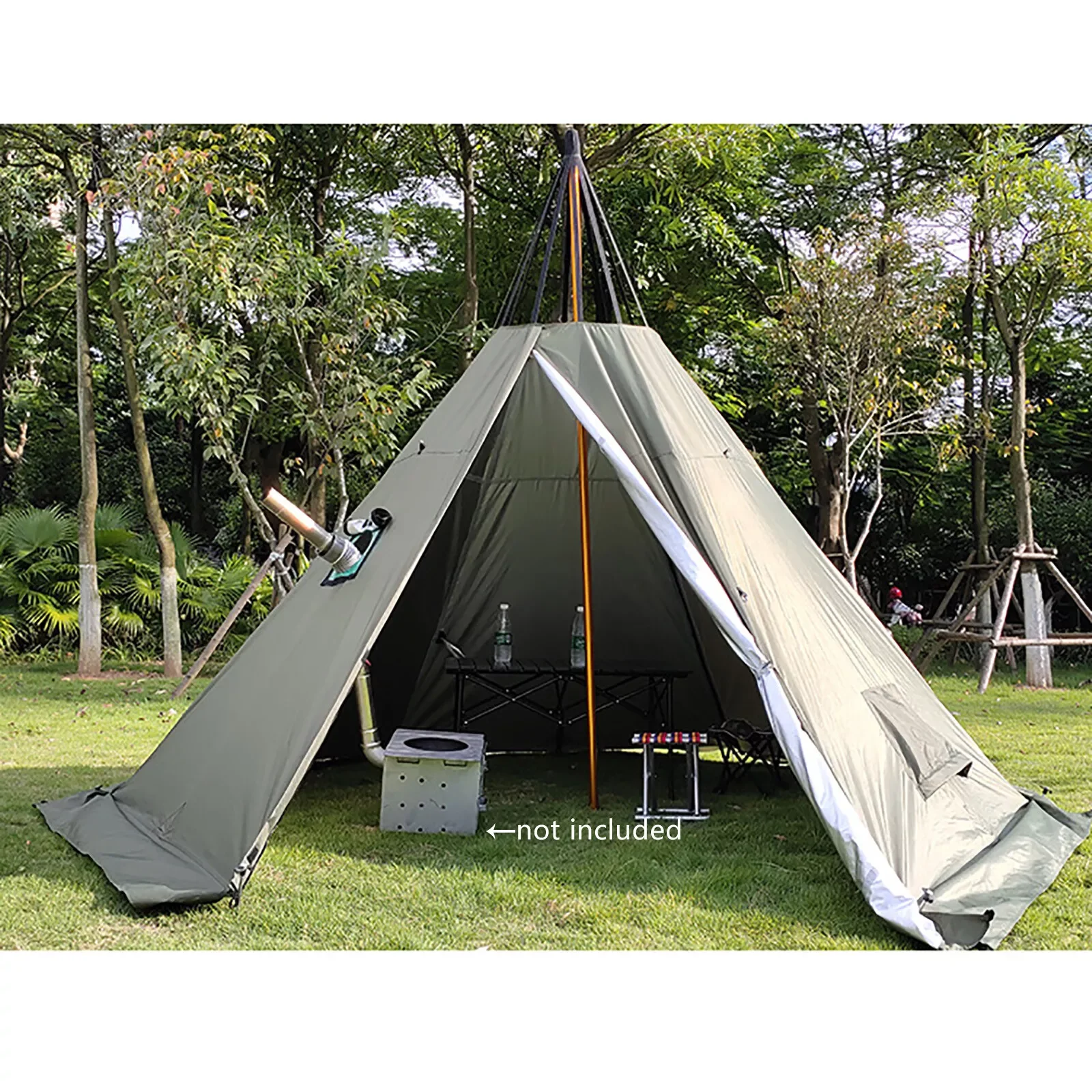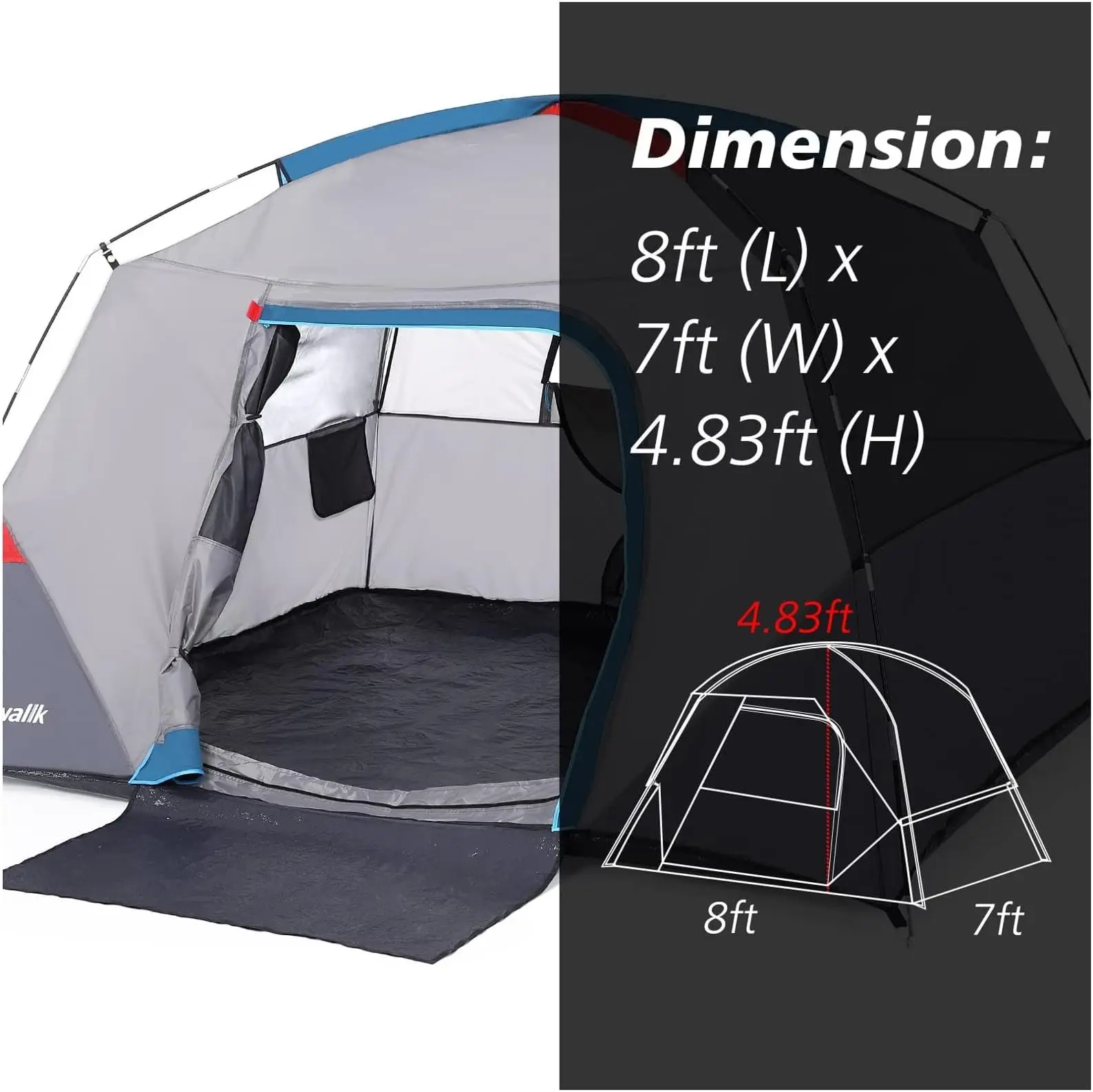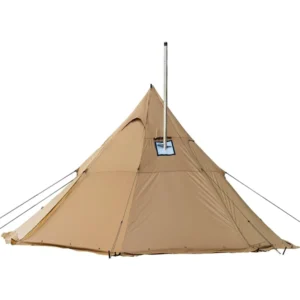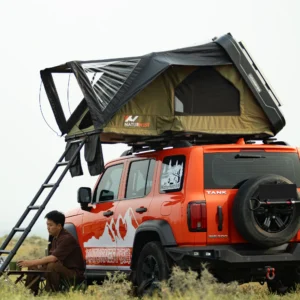Understanding the Importance of Winter-Specific Shelters
When temperatures plummet and snow blankets the landscape, your typical three-season tent simply won’t cut it. Standard shelters that perform admirably in mild conditions often become dangerous liabilities in winter’s harsh embrace. The fundamental issue lies in their basic design – they’re built for rain and moderate wind, not for heavy snow loads and fierce winter storms.
Consider this scenario: A hiker settles into their lightweight summer tent as an unexpected snowstorm rolls in. By morning, the tent poles have buckled under just four inches of wet snow, leaving the hiker exposed to potentially life-threatening conditions. This isn’t just theoretical – rescue organizations report that shelter failure contributes to approximately 30% of winter hiking emergencies.
The differences between three-season and winter-ready shelters go far beyond superficial features. Winter shelters incorporate substantially stronger pole structures, more comprehensive weather coverage, and sophisticated ventilation systems designed specifically for subfreezing conditions. These aren’t luxury upgrades – they’re essential safety features.
Understanding these critical differences can literally be a matter of survival, especially when temperatures can plunge to -20°F (-29°C) or lower in popular winter hiking destinations. The ultimate guide to compact shelters provides a foundation, but winter conditions demand specialized knowledge.
Key winter shelter considerations include:
– Structural integrity under snow load
– Wind resistance in exposed terrain
– Temperature management and condensation control
– Setup feasibility with gloves and in challenging conditions
The right 4-season winter 2-person tent makes the difference between a memorable adventure and a dangerous situation. Let’s explore what makes these shelters different from their fair-weather counterparts.
Critical Structural Features for Snow and Wind Resistance
The architecture of a winter shelter forms its first line of defense against harsh conditions. Two primary designs dominate the winter landscape: geodesic domes and tunnel configurations, each offering distinct advantages for snow load management.
Pole Architecture and Materials
Winter-worthy shelters use substantially more robust pole structures than their three-season counterparts:
- Pole diameter: Winter shelters typically feature poles between 9-11mm in diameter, compared to the standard 8.5mm in three-season tents
- Materials: Aircraft-grade aluminum alloys (often 7000-series) provide the optimal balance of strength and weight
- Pole intersections: Four-way crossing points create superior stability compared to two or three-way intersections
- Quantity: Additional poles and crossing points distribute snow load more effectively
Reinforcement Systems
The connection points between poles and tent body face enormous stress during winter storms:
– Reinforced anchor points with double or triple stitching
– Strategic gussets at high-stress junctions
– Heavy-duty webbing and hardware at critical attachment points
– Load distribution panels that spread tension across wider fabric areas
Anchoring for Snow and Ice
Winter anchoring systems differ dramatically from standard tent stakes:
– Extended snow stakes designed to maximize surface area
– Deadman anchor capabilities for deep snow deployment
– Multiple guy-out points (8-12 vs. 4-6 on three-season tents)
– Reflective guy lines in varying thicknesses (3-4mm for winter conditions)
Fabric Considerations
Winter shelter fabrics must withstand abrasion from ice and snow while maintaining integrity:
– Higher denier ratings (50-70D vs. 15-30D for lightweight tents)
– Ripstop patterns with reinforced weaving
– Specialized coatings that maintain flexibility in subfreezing temperatures
The robustness of these specialized snow camping tent features directly impacts survivability in extreme conditions. For maximum protection in challenging environments, heavy-duty 4-season tents offer the most comprehensive structural integrity.
Weather Barrier Technologies: Keeping Elements Out
Winter shelters must create an effective barrier against multiple threats: driving snow, freezing rain, howling winds, and temperature extremes. The technologies that accomplish this protection go far beyond what’s found in standard camping equipment.
Waterproof Performance
Winter waterproofing requires substantially higher specifications than three-season equipment:
- Hydrostatic head ratings: Winter shelters require minimum 3000mm for rainfly and 5000-10000mm for floors (compared to 1200-1500mm in three-season tents)
- Seam construction: Critical seams use taped, welded or double-stitched construction
- Coating technology: Silicone and polyurethane coatings applied to both sides of fabric
Understanding the technical aspects of tent waterproof ratings helps you make informed decisions about appropriate protection levels.
Snow-Specific Design Elements
Winter shelters incorporate specialized features to manage snow:
- Full-coverage rainflies: Extend nearly to ground level (less than 2-inch gap)
- Snow skirts/valances: Extra fabric panels that can be buried in snow to create a complete seal
- Panel shaping: Steep wall angles prevent snow accumulation
- Reinforced peak designs: Prevent collapse at the highest stress point
Entry and Access Points
Winter shelters feature specialized doorway designs:
– Protected zipper channels with storm flaps
– Anti-freezing zipper treatments and oversized pulls for gloved operation
– Vestibule entries designed to prevent snow incursion
– Multiple entry options for emergency egress

Condensation Management: The Winter Shelter Challenge
Condensation presents a unique challenge in winter shelters. When warm, moisture-laden breath meets freezing tent walls, it immediately transforms into frost or water droplets. This isn’t just uncomfortable—it can compromise gear and create dangerous moisture in sleeping bags.
The Condensation Equation
Understanding the physics helps solve the problem:
– A single person typically releases 1-2 pints of moisture through respiration overnight
– In sub-freezing conditions, this moisture immediately condenses on cold surfaces
– Multiple occupants compound this issue dramatically
– Wet gear brought inside creates additional moisture sources
Double-Wall vs. Single-Wall Design
The two primary winter tent architectures handle condensation differently:
Double-Wall Designs:
– Create dedicated thermal barrier between inner tent and fly
– Allow moisture to pass through breathable inner tent material
– Trap condensation on the underside of the rainfly
– Provide superior comfort but with weight penalty
Single-Wall Designs:
– Utilize advanced breathable-waterproof fabrics
– Reduce weight and setup complexity
– Require more active ventilation management
– Perform best in very cold, dry conditions
Strategic Ventilation Systems
Winter shelters feature specialized ventilation options:
– Hooded/protected vents that prevent snow entry
– Adjustable openings that can be operated while inside the shelter
– Multi-position settings for different conditions
– High/low ventilation pairs that create natural convection airflow
For a comprehensive solution to winter moisture management, winter camping tents offer specialized ventilation systems designed specifically for cold conditions.
Interior Space Design: Comfort in Confined Winter Conditions
Winter camping requires significantly more interior space than fair-weather adventures. Bulky clothing, extra gear, and longer periods confined inside demand thoughtful design considerations for liveability.
Vestibule Requirements
The entryway area serves critical functions in winter camping:
– Minimum recommended vestibule size: 8-10 square feet per person
– Sufficient height for sitting while removing boots and outer layers
– Hard separation between wet and dry zones
– Cooking capabilities with proper ventilation
– Gear storage that prevents snow from entering main living area
Understanding tent vestibule functionality is especially important for winter camping success.
Interior Volume Realities
Winter shelters require careful consideration of actual usable space:
– “Person” ratings typically assume summer conditions
– Winter reality: A 2-person tent comfortably fits one person with winter gear
– Recommended minimum floor area: 25-30 square feet per person (vs. 15-20 square feet in summer)
– Critical minimum height: 36-40 inches for comfortable sitting
Organization Systems
Extended storm periods demand better organization:
– Internal pockets positioned for access without bringing snow inside
– Gear lofts for drying smaller items
– Attachment points for hanging lights and gear
– Reflective interior materials to maximize available light
Setup Features for Cold-Weather Conditions
Setting up shelter in winter conditions presents unique challenges that require specialized design features. When you’re wearing gloves in howling wind with snow underfoot, every detail matters.
Cold-Friendly Components
Winter shelters incorporate features specifically for cold-weather setup:
– Large, glove-compatible clips instead of small hooks
– Color-coded poles and connection points
– Oversized zipper pulls that can be operated with mittens
– Simplified pole sleeves or external clip systems
Snow-Specific Pitching Methods
Securing a shelter on snow requires different techniques:
– Freestanding designs that don’t rely on traditional staking
– Snow-fluke stakes with large surface area
– “Deadman” anchor capabilities using buried objects (sticks, packs, etc.)
– Reinforced guy line attachment points
Fly-First Setup Options
Some winter shelters offer alternative pitching methods:
– Fly can be erected first, protecting inner tent from precipitation
– Unified pitching systems where fly and body rise together
– Modular components that can be configured based on conditions
The ease of choosing the ultimate compact shelter for two depends on these practical setup features, especially in winter conditions.

Winter Shelter Types: Matching Features to Your Needs
Winter shelters come in various forms, each designed for specific conditions and use cases. Understanding the strengths and limitations of each type helps you make informed choices.
| Shelter Type | Weight Range | Protection Level | Setup Time | Best Use Case |
|---|---|---|---|---|
| Four-Season Expedition Tent | 8-12 lbs (3.6-5.4 kg) | Excellent | 5-10 minutes | Extended trips, extreme conditions |
| Four-Season Treeline Tent | 5-8 lbs (2.3-3.6 kg) | Very Good | 4-8 minutes | Weekend trips, moderate conditions |
| Bivy Sack | 1-3 lbs (0.5-1.4 kg) | Fair to Good | 1-2 minutes | Emergency shelter, minimalist approach |
| Snow Cave/Quinzhee | 0 lbs (shovel required) | Good | 60-120 minutes | Deep snow conditions, extended stays |
| Tarp with Snow Walls | 1-2 lbs (0.5-0.9 kg) | Poor to Fair | 15-30 minutes | Ultralight trips, good weather windows |
Four-Season Tents
These purpose-built shelters offer the most reliable protection:
– Expedition models: Designed for the harshest environments with maximum strength
– Treeline models: Lighter compromise for less extreme conditions
– Features: Full storm protection, robust ventilation, complete insect protection
Bivy Shelters
These minimalist options serve specific purposes:
– Emergency backup to primary shelter
– Ultralight approach for experienced winter campers
– Limited space but maximum portability
– Often combined with other shelter components
Snow Shelters
Natural snow structures provide surprisingly effective protection:
– Snow caves and quinzhees utilize snow’s insulating properties
– Require tools and significant construction time
– Provide stable interior temperatures but limited comfort
Understanding various camping shelter options for two helps you make informed decisions, while specialized mountaineering tents offer the highest level of protection for serious winter adventures.
Selection Criteria: Matching Features to Your Winter Adventure
Choosing the right winter shelter requires balancing multiple factors to match your specific adventure profile. Consider these key decision points:
Trip Duration and Intensity
- Weekend trips: Allow compromise toward lighter weight
- Expedition length: Prioritize durability and weather protection
- Remote locations: Require redundancy and repair options
- Established campsites: Permit heavier but more comfortable options
Terrain Assessment
- Alpine/exposed: Demands maximum wind resistance and structural integrity
- Forested/protected: Allows focus on other features beyond wind resistance
- Deep snow regions: Require enhanced snow-loading capability
- Mixed conditions: Benefit from adaptable shelter systems
Group Dynamics
- Solo travelers: Consider bivouac or smaller four-season options
- Pairs: Standard two-person winter tents typically accommodate one person with gear
- Groups: Multiple smaller shelters often provide better options than single large tent
The benefits of windproof tents for snow become particularly important when selecting shelter for exposed winter conditions.
Lightweight Backpacking Tent, Ultralight Backpacking Tent, Waterproof Backpacking Tent
$391.05 Select options This product has multiple variants. The options may be chosen on the product pageHeavy Duty 4 Season Tent, Mountaineering Tent, Winter Camping Tent
$870.40 Select options This product has multiple variants. The options may be chosen on the product pageUltralight Backpacking Tent, Ultralight Dome Tent, Winter Camping Tent
Price range: $369.63 through $370.07 Select options This product has multiple variants. The options may be chosen on the product pageHeavy Duty 4 Season Tent, Ultralight Freestanding Tent, Winter Camping Tent
$3,722.66 Select options This product has multiple variants. The options may be chosen on the product pageHeavy Duty 4 Season Tent, Winter Camping Tent
$638.69 Select options This product has multiple variants. The options may be chosen on the product pageHeavy Duty 4 Season Tent, Winter Camping Tent
$5,109.59 Select options This product has multiple variants. The options may be chosen on the product page
Safety Features: Beyond Basic Protection
Winter shelters include critical safety features that go beyond keeping elements out. These design elements can be life-saving in emergency situations.
Ventilation for Carbon Monoxide Prevention
Cooking inside or near shelters creates serious risks:
– Specialized ventilation systems that function even when zipped closed
– Carbon monoxide-proof materials that don’t absorb dangerous gases
– Clear markings for safe cooking zones within vestibules
– Warning indicators and safety guidance included with winter-specific tents
Emergency Considerations
Winter shelters incorporate features for worst-case scenarios:
– High-visibility colors for location identification in storms or rescues
– Reflective elements on guy lines and tent bodies
– Multiple exit points for emergency egress
– Repair materials designed for cold-weather application
Structural Safety Margins
Quality winter shelters include engineering safety factors:
– Design tolerances exceeding expected conditions by 20-30%
– Redundant support systems that prevent catastrophic failure
– Reinforced stress points that distribute unexpected loads

Complementary Winter Shelter Systems: Creating a Complete Protection Strategy
Your shelter works as part of an integrated system. The following components work together to create comprehensive winter protection:
Sleep Surface Insulation
The ground draws heat away faster than air, especially on snow:
– Minimum recommended sleeping pad R-value: 5.0+ for snow camping
– Layering multiple pads creates redundancy and enhances warmth
– Closed-cell foam provides reliable insulation even when damaged
– Insulated air pads offer comfort while maintaining thermal performance
Sleeping Bag Integration
Your sleeping bag works in concert with your shelter:
– Temperature ratings should exceed expected conditions by 10-15°F
– Vapor barrier systems prevent moisture accumulation in insulation
– Proper lofting space required within the shelter dimensions
Ground Protection Systems
Winter conditions demand specialized floor protection:
– Footprints sized specifically for winter models
– Abrasion-resistant materials that remain flexible in cold
– Waterproof ratings exceeding 7000mm for snow conditions
Learning proper two-person lightweight tent setup techniques translates well to winter shelter systems with some cold-specific adaptations.
Smart Winter Shelter Storage and Maintenance
Winter conditions accelerate wear on shelter materials. Proper maintenance extends life and ensures reliability when you need it most.
Between-Trip Storage
- Never store wet or damp (mildew damage is permanent)
- Avoid compression that breaks down waterproof coatings
- Store poles loosely assembled to preserve shock cord elasticity
- Keep in cool, dry place away from direct sunlight
Field Care Techniques
- Brush snow off before packing when possible
- Carry dedicated sponge for condensation management
- Use snow to clean stubborn dirt (abrasives damage coatings)
- Pack wet components separately when possible
Preventative Maintenance
- Inspect and renew seam sealing annually
- Check and replace damaged guy lines before trips
- Test DWR effectiveness and reapply as needed
- Verify pole integrity, especially at ferrel connections
To ensure long-term performance, waterproof backpacking tents require proper maintenance to preserve their protective qualities.
Today’s Innovation in Winter Shelter Technology
The winter shelter market continues to evolve with impressive technological advances that enhance performance while reducing weight and environmental impact.
Material Science Advancements
- Nano-fiber fabrics that enhance breathability while maintaining waterproofing
- Carbon-fiber pole technologies that reduce weight by 20-30% while increasing strength
- Environmentally sustainable PFC-free waterproofing treatments
- Multi-layer composite fabrics that adapt to temperature conditions
Design Innovations
- Quick-convert systems that modify from full winter protection to lighter configurations
- Modular components that can be configured based on conditions
- Integrated smart sensors for temperature and humidity monitoring
- Hybrid designs that combine benefits of multiple shelter types
Sustainability Focus
The outdoor industry increasingly prioritizes environmental responsibility:
– Recycled materials in fabrics and poles
– Repair-focused design with replaceable components
– PFC-free waterproofing treatments
– Carbon-neutral manufacturing processes
Conclusion: Finding Your Ideal Winter Protection System
Selecting the right winter shelter requires careful consideration of your specific needs, conditions, and experience level. The critical features we’ve explored – structural integrity, weather resistance, condensation management, interior design, setup features, and safety elements – all work together to create a comprehensive protection system.
Remember that winter shelters represent a significant but worthwhile investment in your safety and comfort. Quality winter shelters start at a higher price point than three-season options but provide essential protection when conditions deteriorate.
Before committing to winter camping, practice setting up your shelter in challenging conditions. Familiarity with your gear becomes critical when fingers are cold and daylight is limited. Consider testing your shelter in progressively more challenging conditions as your experience grows.
Above all, prioritize safety margins in your selection. Choose a shelter that exceeds your expected conditions rather than merely meeting them. In winter environments, the right shelter isn’t just about comfort—it’s an essential safety tool that creates a crucial barrier between you and potentially dangerous conditions.
The perfect winter shelter balances protection, weight, livability, and your specific adventure profile to create a reliable home in the winter wilderness.







